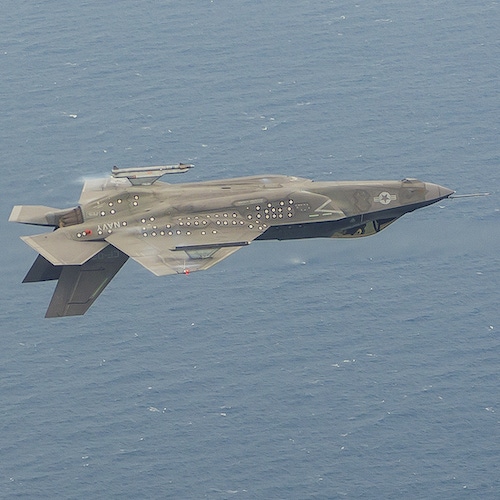
Once upon a time, long before he was doing clever wireless stuff as the boss of Cohere Technologies, Ray Dolan flew tactical fighter jets for the US Marine Corps. James Taiclet, the president of Lockheed Martin, would have had similar exposure to bone-crushing Gs as a former pilot and instructor for the US Air Force. When the two men team up at Mobile World Congress a few weeks from now to speak about "going hypersonic," Gs of both the gravitational and mobile varieties could effectively meet for the first time.
Lockheed Martin is a major US Department of Defense (DoD) supplier that churns out F-35 planes, Trident missiles and the odd satellite or two. Cohere, among other things, develops a wireless technology called orthogonal time frequency space (OTFS). An alternative to the orthogonal frequency division multiplexing (OFDM) found in today's 4G and 5G networks, OTFS is pitched by Cohere as a candidate for the upcoming 6G standard, still several years away from commercialization. For the hardware that Lockheed Martin builds, it is potentially ideal.
"OFDM has a problem at super-high speeds," said Ronny Haraldsvik, Cohere's senior vice president of business development, during an interview with Light Reading. "There are satellites going at 17,000 miles an hour and they need to communicate with each other. There are supersonic flights and low-latency apps that need to be rapidly sent from air to land. There needs to be a fix and DoD entities have unique applications where they don't care if it is standard or not and want to start testing now. Then standards can follow later."
Figure 1:  One of Lockheed Martin's F-35s, upside-down after firing a missile.
One of Lockheed Martin's F-35s, upside-down after firing a missile.
(Source: Lockheed Martin)
The vision of a 6G-standardized OTFS integral to future military systems will alarm any US official concerned about China's role in global standards bodies. But the immediate obstacle for Cohere is likelier to be vested commercial interests – entities that have profited from OFDM's importance to mobile standards and that fear an OTFS challenge. This said, if it were solely about "hypersonic" connectivity, OTFS would be targeting a relatively small part of the 6G market, and Haraldsvik insists the goal is not to replace OFDM. "We know we can have the existence of two waveforms without penalizing performance."
Hypersonic, however, is not the full OTFS story. Running mobile network functions from the cloud might be easier with OTFS than it is with OFDM because the former can better "live with latency," in Haraldsvik's words. In this scenario, site equipment becomes dumber as network intelligence moves to servers in more centralized facilities. This would obviously suit the likes of AWS, Google Cloud and Microsoft Azure as they pitch for telco business. Vendors in the traditional basestation market are unlikely to be quite so enthusiastic.
Unaccommodating
They are probably not thrilled by Cohere's other products, either. Chief among them is the universal spectrum multiplier (USM), a software-based system designed to boost performance on the radios telcos have already deployed. No big kit vendor is likely to welcome third-party software that prolongs the lifetime of older equipment and hinders sales of new, antenna-rich gear. Unsurprisingly, then, Ericsson, Huawei and Nokia, the dominant players in this market, have not made room for the USM.
This is an obvious problem for Cohere, Haraldsvik concedes. Its remedy is twofold. First, it is appealing directly to network operators lured by the service benefits and economic attractions of its technology. Its investors now include the venture-capital arms of two operators – Bell Canada and Australia's Telstra – and it has been tested or trialed by several telcos. Ignoring the demands of customers impressed with Cohere will be much harder for Ericsson and company than simply ignoring Cohere.
Separately, Cohere is backing open RAN, a set of interfaces for slotting together products from different suppliers, rather than buying the whole enchilada from one big vendor. Open RAN specialists trying to crack the oligopolistic sector may have nothing to lose and plenty to gain from a Cohere tie-up. While it has yet to announce any such partnerships with RAN software developers, Haraldsvik's message is to watch this space.
Building blocks
Open RAN might help Cohere technically, as well. Rather than being integrated with a RAN partner's products, Cohere's software could sit on a platform called the RAN intelligent controller (or RIC), a concept born of the open RAN community. Two flavors of RIC are available – near-real time (with xApps) and non-real time (with rApps). Having previously seemed to focus on xApps, Cohere now says it can support either. If there are no service drawbacks, that should extend its market reach.
Cohere's latest innovation, announced this week, is a tool called dynamic network alignment (snappily shortened to DNA). It is described by Haraldsvik as an autoconfiguration tool, intended to work alongside the USM, and was conceived following USM trials with an undisclosed telco. As Cohere quickly discovered, operators might be using numerous antenna configurations in the field, where conditions can rapidly change from one moment to the next. Weather fronts, highway traffic and even the appearance of a new billboard can all cause disruption, according to Haraldsvik. "We discovered we had to do something that auto-calibrated," he said. "You can see things have changed and then fine tune."
The industry is still waiting for Cohere to make its breakthrough after several years of talk about the USM product. A major deal with a telco today would require established kit vendors to budge. Greenfield work involving smaller suppliers seems likelier for now. But 6G is slowly drawing closer, and telcos aren't getting any richer. Odd as it sounds, that might just suit Cohere.
Related posts:
— Iain Morris, International Editor, Light Reading
About the Author(s)
You May Also Like











